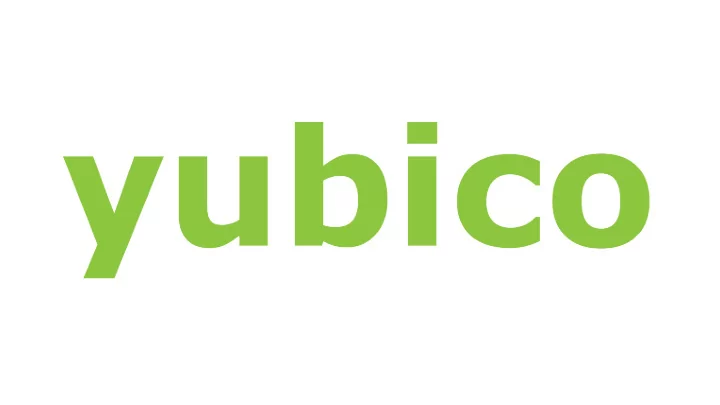

Universal 2 nd Factor 2015-02-01 FOSDEM Security devroom Simon Josefsson simon@yubico.com
What is U2F?
The U2F solution One device, many services Easy: Insert and touch button Safe: Unphishable Security
Pre-History of U2F: Gnubby Yubico designed a precursor to U2F with Google and NXP. Deployed to Google staff around the world. To reach mass market, standardization and multiple vendors are needed. During 2012 the FIDO Alliance started working on U2F.
Over 150 members
What is this U2F protocol? Core idea: Standard public key cryptography • User's device mints new key pair, ”registers” public key and key-handle with server • Key handle contain data to restore private key on device • Server provides key-handle and asks user's device to sign data to verify the user • One device, many services - “ Bring Your Own Authenticator ” Design considerations • Privacy: Site-specific keys, no unique device ID • Security : No phishing or man-in-the-middle, no soft private keys • Trust : User decides what authenticator to use • Pragmatics : Affordable today • Usability : No delays, fast crypto on device, no driver installs
Think: Driverless smartcard for the modern consumer web, plus privacy
USB today, the world tomorrow NFC Hardware separation important! Software in complex hosts too fragile → keys stolen on 0day vuln.
U2F entities Relying party User Side U2F device Browser Web Application FIDO Client User Action U2F JS API Secure U2F U2F library Element Public Key + Transport U2F code KeyHandle USB (HID) USB (HID) API
Demo
Authentication Browser - Relying U2F Device FIDO Client Party handle, app id, challenge check h a app id retrieve: h, a; challenge, origin, channel id, etc. key k pub retrieve: c from key k priv handle h from counter, signature(a,c,counter) handle h; counter++ s counter, c, s check: signature using key k pub set cookie
U2F Authentication JSON blobs Server sends: { "keyHandle": "yQ_cxLOEDDrQ1rGesE249- QYNjGoNWpY2QRSQzE9p0qQZNk2i3Z6ioYAAumOZnJQhuQDJ2VVtOcUD85kYRdjuQ", "version": "U2F_V2", "challenge": "cDftdgcY3SOYMaKPq6JFt0nmpFACTZuJ5EbRr-VTnxA", "appId": "http:\/\/example.org" } Client responds: { "signatureData": "AQAAADMwRgIhAKCAGKKDcZe1Rt4HdOnD2JkF5yU711AxjngH_-dW9- e5AiEAylw5kzYKRg2rSl0JU1zsJibF3MIWtOCXGv1h4KazCys=", "clientData": "eyAiY2hhbGxlbmdlIjogImNEZnRkZ2NZM1NPWU1hS1BxNkpGdDBubXBGQUNUWnVKNUViUnI tVlRueEEiLCAib3JpZ2luIjogImh0dHA6XC9cL2V4YW1wbGUub3JnIiwgInR5cCI6ICJuYXZpZ2F0b 3IuaWQuZ2V0QXNzZXJ0aW9uIiB9", "keyHandle": "yQ_cxLOEDDrQ1rGesE249- QYNjGoNWpY2QRSQzE9p0qQZNk2i3Z6ioYAAumOZnJQhuQDJ2VVtOcUD85kYRdjuQ" }
USB HID Authenticate
Registration Browser - Relying U2F Device FIDO Client Party app id, challenge check a app id a; challenge, origin, channel id, etc. generate: key k pub c key k priv k pub , h, attestation cert, signature(a,c,k pub ,h) handle h c, k pub , h, attestation cert, s s cookie store: key k pub handle h for user
U2F Register JSON blobs Server sends: { "challenge": "oVXT29EiA16cFFIQCzwPp-waGiMahI2WIevJXcFQCVc", "version": "U2F_V2", "appId": "http:\/\/example.org" } Client responds: { "registrationData": "BQQ91soQ8zQlX- yBzGJtOWMvKbWPkIsOqA_1psdwK7fid03vAXcDreXFFgcYEaxI5dUyWcs3jiw67Z_D0KxZMTP2 QMkP3MSzhAw60NaxnrBNuPfkGDYxqDVqWNkEUkMxPadKkGTZNot2eoqGAALpjmZyUIbkAydl VbTnFA_OZGEXY7kwg...W_AMRED0ExAGowC0YQMvgbqWGZiZAiBUt00SBB1TTtFfbwr4Lp1da S5L6gqMQxtiHIrHjZwFKw==", "clientData": "eyAiY2hhbGxlbmdlIjogIm9WWFQyOUVpQTE2Y0ZGSVFDendQcC13YUdpTWFoSTJXSWV2Slhj RlFDVmMiLCAib3JpZ2luIjogImh0dHA6XC9cL2V4YW1wbGUub3JnIiwgInR5cCI6ICJuYXZpZ2F0 b3IuaWQuZmluaXNoRW5yb2xsbWVudCIgfQ==" }
Registration: USB HID
Application and Facet ID's Application A set of functionality provided by a common entity (the application owner), and perceived by the user as belonging together. For example, PayPal is an application that allows users to pay for stuff. Facets An (application) facet is how an application is implemented on various platforms. For example, the application PayPal may have an Android app, an iOS app, and a Web app. These are all facets of the PayPal application. Facet ID A platform-specific identifier (URI) for an application facet. Simplest case: facet id and application id is the same. For the Web, the Facet ID is the web origin, written as a URI without a path (e.g. https://login.paypal.com ). ● For Android, the Facet ID is the URI android:apk-key-hash:<hash-of-apk-signing-cert> . ● For iOS, the Facet ID is the URI ios:bundle-id:<ios-bundle-id-of-app> . ●
What if I want to support U2F? • Server/Browser: Call Javascript APIs o Send key handle in HTML/JavaScript to browser • Server: Implement registration flow o Decide how to handle attestation certificates o Verify registration response o Store public key, key handle with user account • Server: Implement login flow o Check username/password, look up key handle o Verify authentication response (origin, signature, counter, …) • Relying Party: Check your account recovery flow
So many keys... ● Authentication public/private key o Unique for every RP o Generated during U2F Registration o Public key sent to RP during Registration o Key handle can be used to derive private key Unlimited number of RPs on small device o Hard coded to ECDSA using NIST P.256 curve
So many keys... ● Device-unique symmetric secret o Unwrap/derive per-RP ECDSA key from key handle o Unique random key for every device o Yubico derives private key using HMAC-SHA256
Yubico’s U2F KeyHandle ● Key handle is nonce+MAC instead of encrypted ● Device can derive ECDSA private key from nonce and symmetric device secret ● MAC detects invalid key handle or malicious RP
So many keys... ● ECDSA attestation key (unique per batch) o Linked with device attestation certificate o Signs U2F Registration blobs
U2F attestation ● Proves what U2F device the user used ● X.509 Certificate with batch-unique key ● Why batch-unique and not device-unique? o Privacy: device-unique key permits conspiring RPs to link a physical key to particular user o Common batch size could be 10k-100k (could be 1 - breaking the privacy aspects)
Yubico U2F software Our idea is to publish host and server libraries in common languages as FOSS code ● C: libu2f-host & libu2f-server ● Java: java-u2flib-server ● PHP: php-u2flib-server ● Python: python-u2flib-host & python-u2flib-server
U2F C Libraries ● github.com/Yubico/libu2f-{server,host} ● Portable C99 few dependencies (json, OpenSSL, HIDAPI) ● server: Generate U2F challenges and verify responses ● host: Parse challenges and talk USB to get responses ● Command line tool
Resources Libraries, Plugins, Sample Code, Documentation developers.yubico.com/U2F U2F Protocol Specification fidoalliance.org/specifications Yubico U2F Demo Server - Test your U2F device here! demo.yubico.com/u2f
Thank you!
Recommend
More recommend